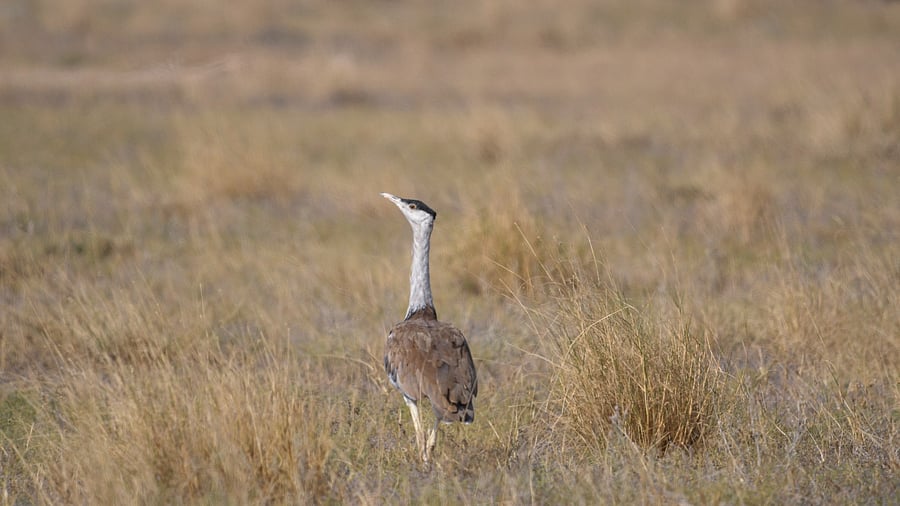
The Great Indian Bustard.
Credit: iStock Photo
Ranebennur Blackbuck Sanctuary (Haveri): Undoing its decades-old mistake, the Forest Department will uproot eucalyptus plantations on nearly 800 hectares of land at the Ranebennur Blackbuck Sanctuary (RBS) in Haveri.
The clearance of the invasive species will help the department fast-track the reintroduction of the Great Indian Bustard (GIB), a bird on the verge of extinction.
If things go according to plan, GIBs could be reintroduced in the sanctuary in the next three years. GIBs need vast tracks of open spaces to keep a vigil on predators. The increase in the green canopy at the sanctuary has also adversely impacted other grassland species like blackbucks and wolves. Six to eight leopards have replaced wolves (last sighted at the sanctuary five years ago) as apex predators.
Forest officials and scientists claim that the Blackbuck Sanctuary Management Plan of 2015-16 and 2024-25 is on track and has progressed satisfactorily.
Nearly 80% of the 1,200 ha sanctuary was covered by eucalyptus and other trees. Officials have cleared eucalyptus trees on almost 400 ha of land. Trees on another 200 ha have been tendered to be removed and work is in progress.
As the 10-year RBS management plan ends in 2025, the Forest Department will approach the Union government to allow the extraction of invasive tree species from another 200 ha.
The department intends to clear nearly 1,000 ha of forest area of eucalyptus. The department has so far earned Rs 4.32 crore by selling extracted trees; revenue generated will be utilised for better grassland management, say officials.
Assistant Conservator of Forests, Ranebennur, Satish Pujar said since last year, they have "extracted" over 43,965 eucalyptus trees and in the next few months, the department will remove another 20,350 trees that were planted between 1974 and 1990, as part of improving "green cover" in the region. The protected area was declared a sanctuary in 1974.
Haveri Deputy Conservator of Forests Abdul Azeez Shaikh said removing eucalyptus is not just for the reintroduction of GIBs but to bring in a grassland ecosystem at the sanctuary and also to minimise human-animal conflict involving blackbucks.
"Leaf litters of eucalyptus used to curb the growth of grass forcing the blackbucks to venture out of the park for feeding. More than 40% of the blackbuck population in the region is outside the sanctuary," he said. With the increase in grass within the sanctuary, the amount of compensation provided to farmers for crop damage has reduced this year.
Sutirtha Dutta, a scientist at the Wildlife Institute of India and an expert on GIBs, said Ranebennur was a past stronghold for GIBs. "Removing eucalyptus alone will not suffice. There is a need to bring in the natural ecosystem of grassland here to ensure the GIBs can return to safety," said Dutta.
He says as part of the Bustard Recovery Programme, the National Conservation Breeding Centre in Jaisalmer has been breeding the critically endangered species. Currently, there are about 140 individuals in the wild and the centre houses another 45 chicks, which will be used as founders for captive breeding to augment populations in the wild.
Besides Rajasthan, Karnataka, Gujarat, Maharashtra and Andhra Pradesh are potential areas where these birds can be rewilded. "If grassland habitats are adequately restored in Karnataka, and the Rajasthan forest department and the Union government agree, then GIBs can be released in RBS in the near future," he says.
Highlights - Weeding out Nearly 80 per cent of 1,200-ha sanctuary was covered by eucalyptus and other trees Eucalyptus trees on almost 400 ha of land has been cleared; trees on another 200 ha have been tendered to be removed Forest department intends to clear nearly 1,000 ha of forest area of eucalyptus Removing eucalyptus will aid reintroduction of GIBs and also bring in a grassland ecosystem